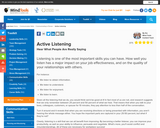
Article and video explain active listening techniques
- Subject:
- Business and Information Technology
- Career and Technical Education
- Material Type:
- Other
- Reading
- Reference Material
- Author:
- Mindtools
- Date Added:
- 05/31/2018

Article and video explain active listening techniques

This is the second semester of the intermediate level sequence intended for students whose conversational ability exceeds their reading and writing skills. Focus is on reading and writing, as well as broadening conversational skills and control of standard pronunciation, for students with background in conversational Chinese. Lab work is required. On completing this course, students should be able to speak the language with standard pronunciation, to converse with some fluency on everyday topics, as well as on some specialized topics, to read edited, as well as authentic texts, in simplified or traditional characters with suitable fluency, and to be able to write composition on certain topics. The class consists of a combination of practice, reading, discussion, dictation, composition and feedback, net exploration via the web, and presentation. This course is conducted in Mandarin.
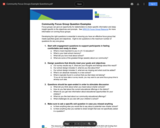
Focus groups can give an opportunity for stakeholders to share specific information and deep insight specific to the objectives and prompts. Developing the right questions is essential in ensuring you have an effective focus group that meets specified goals and objectives. Eight to ten questions is the maximum number of questions for any one group.
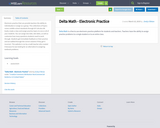
Electronic practice that can provide teachers the ability to individualize or assign as a group. This collections of topics covers middle school standards through AP Calculus AB. Easily create a class and assign practice topics to one or all of your students. You can assign due date, late dates, as well as customize how many questions students need to work through. Students get immediate feedback on their practice and are walked through the correct solution if they get it incorrect. This website is run by a math teacher who created it because he was looking for an alternative to assigning textbook problems.
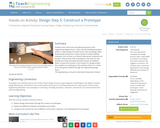
Students learn about the manufacturing phase of the engineering design process. They start by building prototypes, which is a special type of model used to test new design ideas. Students gain experience using a variety of simple building materials, such as foam core board, balsa wood, cardstock and hot glue. They present their prototypes to the class for user testing and create prototype iterations based on feedback. (Note: Conduct this activity in the context of a design project that students are working on; this activity is Step 5 in a series of six that guide students through the engineering design loop.)

The course addresses dynamic systems, i.e., systems that evolve with time. Typically these systems have inputs and outputs; it is of interest to understand how the input affects the output (or, vice-versa, what inputs should be given to generate a desired output). In particular, we will concentrate on systems that can be modeled by Ordinary Differential Equations (ODEs), and that satisfy certain linearity and time-invariance conditions. We will analyze the response of these systems to inputs and initial conditions. It is of particular interest to analyze systems obtained as interconnections (e.g., feedback) of two or more other systems. We will learn how to design (control) systems that ensure desirable properties (e.g., stability, performance) of the interconnection with a given dynamic system.

Introduction to reactor dynamics including subcritical multiplication, critical operation in absence of thermal feedback effects and effects of Xenon, fuel and moderator temperature, etc. Derivation of point kinetics and dynamic period equations. Techniques for reactor control including signal validation, supervisory algorithms, model-based trajectory tracking, and rule-based control. Overview of light-water reactor startup. Lectures and demonstrations with computer simulation and the use of the MIT Research Reactor.
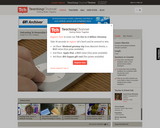
A teacher records suggestions and comments on writing assignments as a podcast that students can access anytime and replay as needed. This allows for timely formative feedback.
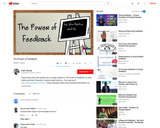
This Powtoon Instructional video explains the concepts outlined in "The Power of Feedback" by John Hattie and Helen Timperley
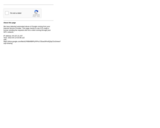
Do you use nature journaling in your instruction? What evidence do students' journal entries provide on what they have learned and where they need to go next in their learning journeys?
In this session, we will: connect with experts and resources on nature journaling; explore practices to give students agency in their learning through self-assessment and peer feedback; and offer ways to improve deliberate practice to grow ideas and approaches.
New resources for nature journaling as well as the How to Teach Nature Journaling book.
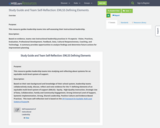
Purpose:This resource guides leadership teams into self-assessing their instructional leadership.Description:Based on evidence, teams rate instructional leadership practices in 10 aspects: Vision, Practices, Evaluation, Professional Development, Feedback, Data, Cultural Responsiveness, Coaching, and Technology. A summary provides opportunities to analyze findings and determine future actions for improvement planning.

Opportunity for group study by students through distance learning on current topics related to management.
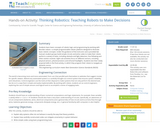
Students learn basic concepts of robotic logic and programming by working with Boe-Bot robotsâa simple programmable robotic platform designed to illustrate basic robotic concepts. Under the guidance of the instructor and a provided lab manual, student groups build simple circuits and write codes to make their robots perform a variety of tasks, including obstacle and light detection, line following and other motion routines. Eight sub-activities focus on different sensors, including physical sensors, phototransistors and infrared headlights. Students test their newly acquired skills in the final activity, in which they program their robots to navigate an obstacle course.
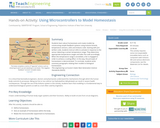
Students learn about homeostasis and create models by constructing simple feedback systems using Arduino boards, temperature sensors, LEDs and Arduino code. Starting with pre-written code, students instruct LEDs to activate in response to the sensor detecting a certain temperature range. They determine appropriate temperature ranges and alter the code accordingly. When the temperature range is exceeded, a fan is engaged in order to achieve a cooling effect. In this way, the principle of homeostasis is demonstrated. To conclude, students write summary paragraphs relating their models to biological homeostasis.